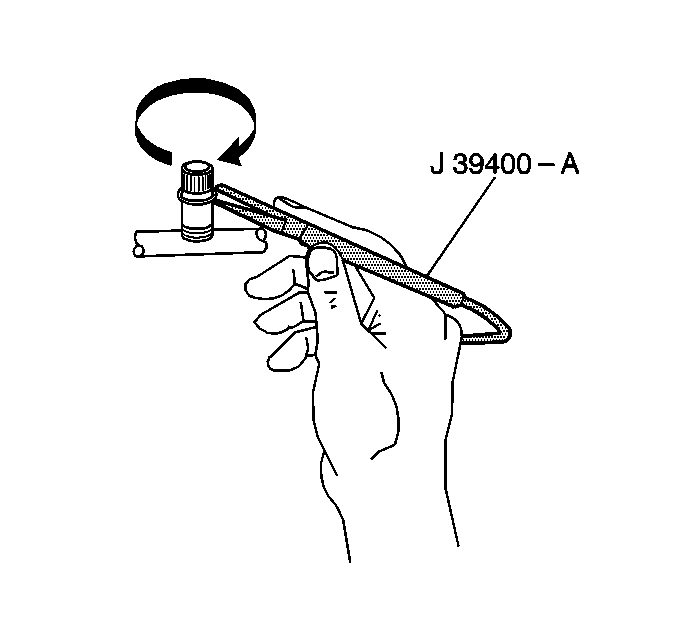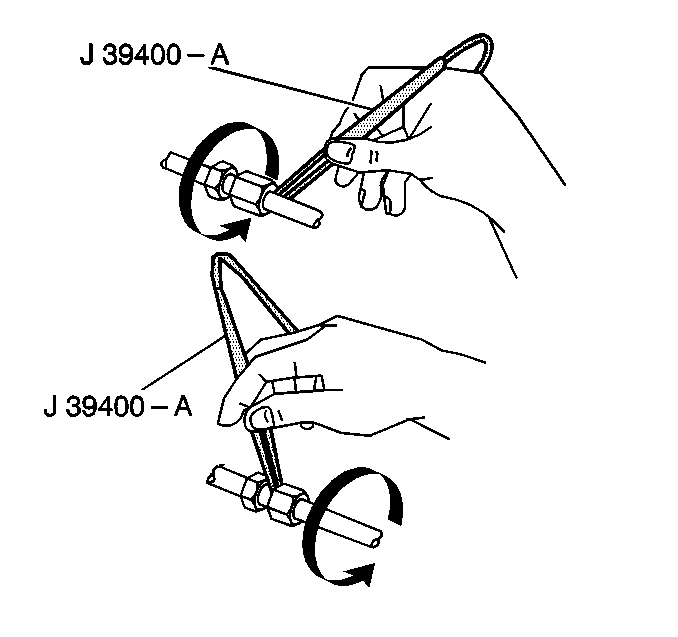Caution: Avoid breathing A/C Refrigerant 134a (R-134a) and lubricant vapor or
mist. Exposure may irritate eyes, nose, and throat. To remove R-134a from
the A/C system, use service equipment certified to meet the requirements
of SAE J2210 (R-134a recycling equipment). If accidental discharge occurs,
ventilate work area before resuming service. Additional health and safety
information may be obtained from refrigerant and lubricant manufacturers.
Caution: Take care to prevent personal injury which could occur due to touching
a hot engine when testing. Tests should be done with the engine "Off"
and as cool as possible. Do not operate the detector in a combustible atmosphere
since its sensor operates at high temperature.
Perform a refrigerant leak test on the system when the
following conditions exist:
| • | A service operation disturbs the components, lines or connections |
Electronic Leak Detector
Tools Required
J 39400 Electronic
Leak Detector
The J 39400
is a
small unit which operates on a 12V DC.
The detector provides an audible signal. The signal increases in frequency
as R-134a is detected.
Use the included instructions in order to ensure that the instrument
is properly calibrated. Ensure that the detector is used in the proper setting
for the type of refrigerant being tested.
Place the detector gas switch in the R-134a setting prior to use.

Inspect the refrigerant fittings and the connections for leaks. The
following conditions may cause leaks:
| • | Lack of lubricant on the O-ring seals |
| • | Dirt or debris across the O-ring seals |
| • | Small pieces of lint from cotton gloves or shop cloths |

When using the electronic leak detector, ensure that the following conditions
exist:
| • | Each joint is completely circled |
| • | The scan rate is 25-51 mm (1.2 in) per second |
| • | The tip of the probe is as close to the surface as possible but
no more than 6 mm (0.25 in) away |
| • | The air intake is not blocked |
Important: Halogen leak detectors are sensitive to the following compounds:
- Windshield washing solutions
- Solvents and cleaners
- Adhesives
In order to prevent a false warning, ensure that all of the surfaces
are clean and dry. The ingestion of liquids will damage the detector.
A leak is indicated when the audible tone changes from a steady 1-2
clicks per second to a solid alarm. Frequently adjust the balance knob in
order to maintain the 1-2 clicks per second rate.
Important: Always follow the refrigerant system around in a continuous path so
that no areas of potential leaks are missed. Always test all of the following
areas in order to ensure that the entire system is leak free,
even when one leak is already found.
Use this procedure in order to test the following areas:
| • | The A/C evaporator inlet and outlet |
| • | The A/C accumulator inlet and outlet |
| • | The A/C condenser inlet and outlet |
| • | All brazed and welded areas |
| • | All areas that exhibit signs of damage |
| • | The A/C compressor rear head |
Service Ports/Access Valves
The sealing gap is the primary seal for the service ports. This cap
contains a specially designed O-ring seal or gasket which provides a leak-free
seal.
The following conditions will result in the loss of refrigerant charge:
A/C Evaporator Core
Leaks in the A/C evaporator core may be difficult to detect. Use the
following procedure in order to test the core:
- Turn the blower fan on HIGH for 15 or more seconds.
- Turn off the blower fan.
- Wait 10 minutes.
- Remove the blower mower resistor.
- Insert the leak detector probe. Be sure to insert the leak detector
as close to the A/C evaporator as possible.
- Listen to the detector. If the detector sounds a solid alarm,
a leak has been found.
- Visually inspect the core face with a flashlight for evidence
of refrigerant oil.
A/C Compressor Block Fitting and Shaft Seal
- Blow shop air behind and in front of the A/C compressor armature/pulley
for 15 seconds or more.
- Wait 1-2 minutes.
- Probe the area in front of the pulley.
- Listen to the detector. If the detector sounds a solid alarm,
a leak has been found.
Leak Inspection
Before disassembling any A/C compressor components, inspect for leaks.
Replace the A/C compressor if a leak is found in any of the following areas:
When Leak Cannot Be Found
Tools Required
The following diagnostic procedure should be used when an A/C refrigerant
leak cannot be found when using a leak detector, J 39400-A.
- Recover the refrigerant from the system and record refrigerant
weight. Refer to
Refrigerant Recovery and Recharging
in this section.
- Add J 41447 Fluorescent Tracer Dye
or GM
P/N 12346303, using J 41459 R-134a A/C Tracer Dye Injector
.
- Recharge the system. Refer to
Refrigerant Recovery and Recharging
in this section.
Important: R 134a florescent dye will remain in the system for the life of the
vehicle as long as the vehicle's A/C system has not been flushed.
- Check the system for leaks using a High Intensity Black Light.


